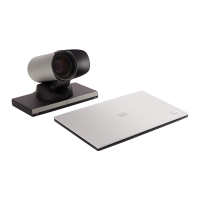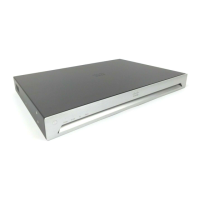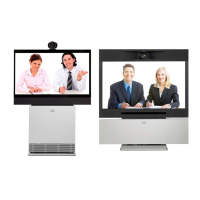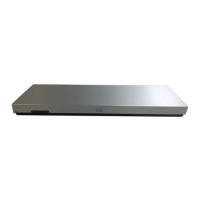D14908.10 SX20 Administrator Guide TC7.3, JULY 2015. www.cisco.com — Copyright © 2012-2015 Cisco Systems, Inc. All rights reserved.
116
Cisco TelePresence SX20 Quick Set Administrator Guide
Video SelfviewDefault PIPPosition
Determine the position on screen of the small self-view picture-in-picture (PiP) after a call. The
setting only takes effect when self-view is switched on (see the Video SelfviewDefault Mode
setting) and fullscreen view is switched off (see the Video SelfviewDefault FullscreenMode
setting).
Requires user role: ADMIN
Value space: <Current/UpperLeft/UpperCenter/UpperRight/CenterLeft/CenterRight/LowerLeft/
LowerRight >
Current: The position of the self-view PiP will be kept unchanged when leaving a call.
UpperLeft: The self-view PiP will appear in the upper left corner of the screen.
UpperCenter: The self-view PiP will appear in the upper center position.
UpperRight: The self-view PiP will appear in the upper right corner of the screen.
CenterLeft: The self-view PiP will appear in the center left position.
CentreRight: The self-view PiP will appear in the center right position.
LowerLeft: The self-view PiP will appear in the lower left corner of the screen.
LowerRight: The self-view PiP will appear in the lower right corner of the screen.
Example:
Video SelfviewDefault PIPPosition: Current
Video SelfviewDefault OnMonitorRole
Determine which monitor/output to display the main video source (self-view) on after a call.
The value reflects the monitor roles set for the different outputs in the Video Output HDMI
MonitorRole settings.
The setting applies both when self-view is displayed in full screen, and when it is displayed as
picture-in-picture (PiP), but only if the Video Monitors setting is set to Dual.
Requires user role: ADMIN
Value space: <First/Second/Current>
First: The self-view picture will be shown on outputs with the Video Output HDMI
MonitorRole set to First.
Second: The self-view picture will be shown on outputs with the Video Output HDMI
MonitorRole set to Second.
Current: When leaving a call, the self-view picture will be kept on the same output as it was
during the call.
Example:
Video SelfviewDefault OnMonitorRole: Current
Video Monitors
A role is assigned to each monitor using the Video Output HDMI [n] MonitorRole setting. The
monitor role decides which layout (call participants and presentation) will appear on the monitor
that is connected to this output. Monitors with different monitor roles will have different layouts.
Both monitors cannot have monitor role First.
The monitor layout mode that is set in the Video Monitors setting should reflect the number of
different layouts you want in your room setup. Note that some monitors can be reserved for
presentations.
Requires user role: ADMIN
Value space: <Auto/Single/Dual/DualPresentationOnly>
Auto: The number of monitors connected to the codec is automatically detected, and the
layout is distributed on the monitors according to the MonitorRole settings.
Single: The layout is shown on one monitor. If two monitors are connected to the codec, one
of them will be disabled.
Dual: The layout is distributed on monitors with monitor role First and Second. If a
presentation is part of the layout, all participants in the call are shown on the monitor with
monitor role First, and the presentation is shown on the monitor with monitor role Second.
DualPresentationOnly: All participants in the call are shown on the monitor with monitor role
First. If a presentation is part of the layout, the presentation is shown on the monitor with
monitor role Second.
Example:
Video Monitors: Auto
Video OSD Mode
The OSD (On Screen Display) is where you find the menus, dialogs, icons and indicators, and
the navigation is done with a remote control. Define which icons and information to be displayed
on screen.
Requires user role: ADMIN
Value space: <Off/On>
Off: Hide the on-screen menus, icons and indicators.
On: Display the on-screen menus, icons and indicators.
Example:
Video OSD Mode: On
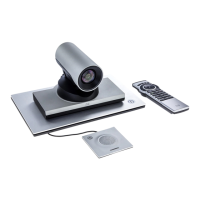
